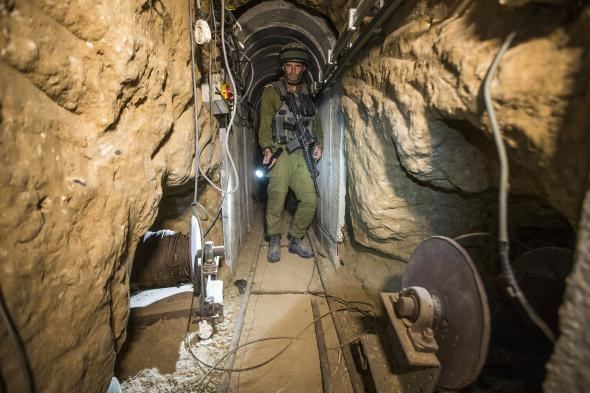 | ||
Tunnel warfare is a general name for war being conducted in tunnels and other underground cavities. It often includes the construction of underground facilities in order to attack or for defence and the use of existing natural caves and artificial underground facilities (catacombs, city communications, etc.) for military purposes. Tunnels can be used to undermine fortifications and slip into territory, while it can strengthen a defence by creating the possibility of ambush, counterattack and the ability to transfer troops from one portion of the battleground to another unseen and protected. Also, tunnels can serve as shelter for combatants and non-combatants from enemy attack.
Contents
- Preview nova secret tunnel warfare
- The origin of tunnel warfare in ancient warfare
- Medieval warfare
- Modern warfare
- Development of mine warfare in the 15th to 18th centuries with the spread of gunpowder
- Crimean War
- American Civil War
- World War I
- World War II
- Korean War
- Vietnam War
- Afghan War
- Bosnian War
- Palestine Israel war
- Lebanon Israeli War
- Famous tunnel war victories
- Tunnels after war
- References
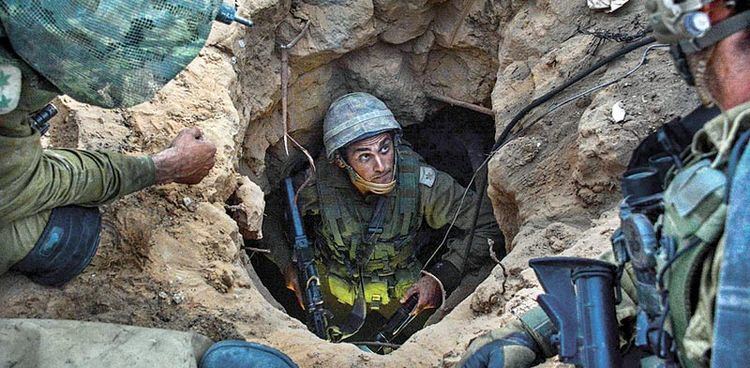
It can be sometimes linked with urban warfare, as tunnels are often found in urban areas and cities, although urban warfare as a whole usually dominates any tunnel considerations.
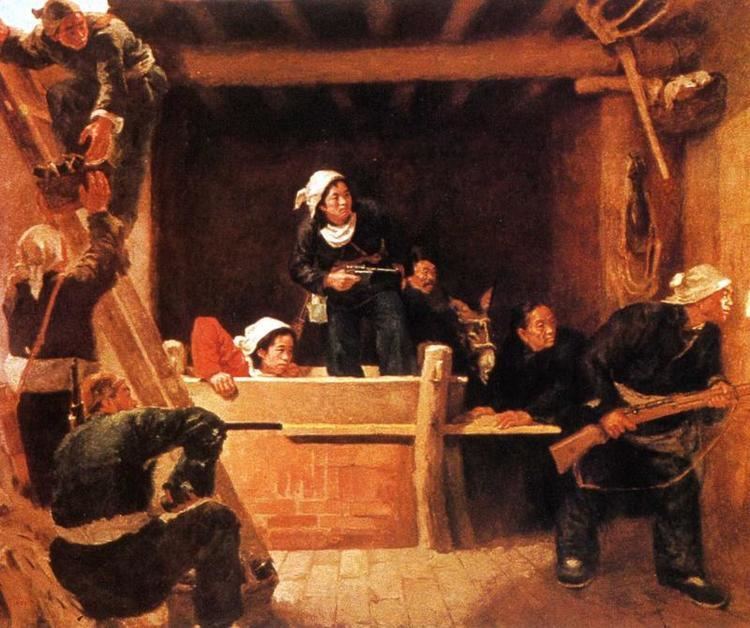
Tunnels, due to their nature, restrict fields of fire and thus any troops in a tunnel usually only have a few areas exposed to fire or sight at any one particular time. Also they can be part of an extensive labyrinth and have cul-de-sacs as well as reduced lighting that can create a closed-in night environment.
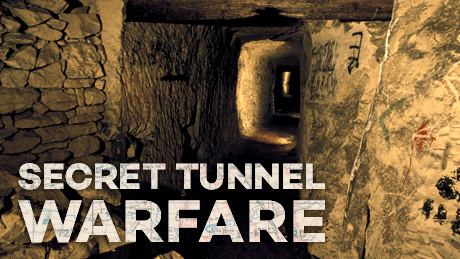
Preview nova secret tunnel warfare
The origin of tunnel warfare in ancient warfare
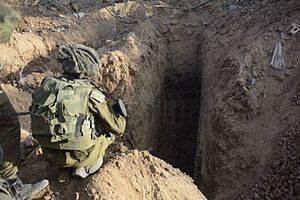
Tunneling in order to mine enemy fortresses and make the walls crumble is an ancient military art that has been put in use all over the world. Polybius describes the Seleucids and Parthians employing tunnels and counter-tunnels during the siege of Sirynx. A famous mine made the walls of Kazan crumble, allowing the Russians to take it. The only countermeasure was to dig down, intercept the mine, and fight the advancing enemy soldiers underground. Sometimes the tunnels collapsed during the fighting, and both sides were buried alive.

The oldest known sources about employing tunnels and trenches for guerrilla-like warfare are Roman. After the uprising in Germania the insurgent tribes soon started to change defence from only local strongholds into utilising the advantage of wider terrain. Hidden trenches to assemble for surprise attacks were dug, connected via tunnels for secure fallback. In action often barriers were used to prevent the enemy from pursuing.

Roman legions entering the country soon learned to fear this warfare, as the ambushing of marching columns caused high casualties. Therefore, they approached possibly fortified areas very carefully, giving time to evaluate, assemble troops and organize them. When the Romans were themselves on the defensive the large underground aqueduct system was utilised in the defence of Rome, as well as to evacuate fleeing leaders.
The use of tunnels as a means of guerrilla-like warfare against the Roman Empire was also a common practice of the Jewish rebels in Judea during the Bar Kokhba revolt (132–136 AD). With time the Romans understood that efforts should be made to expose these tunnels. Once an entrance was discovered fire was lit, either smoking out the rebels or suffocating them to death.
Well-preserved evidence of mining and counter-mining operations has been unearthed at the fortress of Dura-Europos, which fell to the Sassanians in 256/7 AD during Roman–Persian wars.
Medieval warfare
Tunneling was used throughout the world in the medieval period. Often they connected fortifications, towns, villages, religious and political buildings. They were used for supply, communication and as escape routes.
A particular use of tunneling was in mining, where tunnels, braced with timber supports, were dug under the fortifications of besieged castles or towns, which when fired would collapse, bringing down the overlying wall.
Modern warfare
Increased firepower that came with the use of gunpowder, cordite and dynamite made above ground fortifications very expensive if they should withstand any attack. Fortifications were covered with earth and finally they were built totally underground to protect crews and ammunition. For the purpose of firing, artillery and machine gun emplacements had loopholes.
Such a tunnel fortress was difficult to enter and inside there was no room for the attackers to hide from gunfire and explosives. On the other hand, poison gas proved to have a devastating effect.
In trench warfare with heavily fortified strongholds, the tactic of digging and mining the enemy positions was used in the American Civil War during the Siege of Petersburg and the Russo-Japanese War during the Siege of Port Arthur. Extensive mining warfare was conducted by German, French, British and Australian troops on the Western Front during World War I, where the largely static frontlines created favourable conditions for mining.
The largest mining operations were conducted in the Battle of Messines, where specialist Royal Engineer tunnelling companies placed 22 mines under German lines. 19 were eventually exploded, killing about 10,000 German soldiers. Underground attacks especially broke the morale of the enemy if he was surprised in his secure positions. However, the huge craters that are the results of mining enemy positions could be obstacles during an advance, as was found at Petersburg Battle of the Crater and the Somme. Tunnels built to secure frontline supply were built in several places on the Western Front.
On the Eastern Front, the successful Brusilov Offensive employed tunnel/trenches to allow the Russian troops to start the initial assault very close to the Austrian trenches. During World War II, the rapid transit systems that existed in many cities became another military consideration.
The lessons of these battles led to the construction of even bigger systems of defence underground, like the Maginot line or the Westwall with their own infrastructures.
North Korea, it has been claimed, has prepared several transport tunnels with a capacity 10,000 troops per hour for a possible invasion of South Korea. This melds the defensive tunnel warfare with mobile warfare.
The term tunnel war or tunnel warfare (地道战) was first used for the guerrilla tactic employed by the Chinese in the Second Sino-Japanese War. The tunnel systems were fast and easy to construct and enabled a small force to successfully fight superior enemies.
Development of mine warfare in the 15th to 18th centuries with the spread of gunpowder
A major change took place in the art of tunnel warfare in the 15th century in Italy with the development of gunpowder to undermine enemy fortifications.
Ivan the Terrible took Kazan with the use of gunpowder explosions to undermine its walls.
Many fortresses built counter mine galleries, "hearing tunnels" which were used to listen for enemy mines being built. At a distance of about fifty yards they could be used to detect tunnelling.
The Moscow Kremlin had such tunnels.
Since the 16th century during assault on enemy positions saps, dug by sappers, began to be used.
The Austrian general of Italian origin Raimondo Montecuccoli (1609-1680) in his classic work on military affairs described methods of destruction and countering of enemy saps. In his paper on "the assaulting of fortresses" Vauban (1633-1707) the creator of the French School of Fortification gave a theory of mine attack and how to calculate various saps and the amount of gunpowder needed for explosions.
Crimean War
As early as 1840 Eduard Totleben and Schilder-Schuldner had been engaged on questions of organisation and conduct of underground attacks. They began to use electric current to disrupt charges. Special boring instruments of complex design were developed.
In the Siege of Sevastopol (1854-1855) underground fighting became immense. At first the allies began digging saps without any precautions. After a series of explosions caused by counter mine action the allies increased the depth of the tunnels but began to meet rocky ground and the underground war had to return to higher levels. During the siege Russian sappers dug 6.8 kilometres of saps and counter mines. During the same period the allies dug 1.3 kilometres. The Russians expended 12 tons of gunpowder in the underground war while the allies used 64 tons. These figures show that the Russians tried to create a more extensive network of tunnels and carried out better targeted attacks with only minimal use of gunpowder. The allies used outdated fuses so that many charges failed to go off. Conditions in the tunnels were severe: wax candles often went out, sappers fainted due to stale air, ground water flooded tunnels and counter mines. The Russians repulsed the siege and started to dig tunnels under the allies fortifications. The Russian success in the underground war was recognised by the allies. The Times noted that the laurels for this kind of warfare must go to the Russians.
American Civil War
In 1864, during the Siege of Petersburg by the Union Army of the Potomac, a mine made of 8,000 pounds (3,600 kg) of gunpowder was set off approximately 20 feet (6 m) under Maj. Gen. Ambrose E. Burnside's IX Corps sector. The explosion blew a gap in the Confederate defenses of Petersburg, Virginia, creating a crater 170 feet (52 m) long, 100 to 120 feet (30 to 37 m) wide, and at least 30 feet (9 m) deep. From this propitious beginning, everything deteriorated rapidly for the Union attackers. Unit after unit charged into and around the crater, where soldiers milled in confusion. The Confederates quickly recovered and launched several counterattacks led by Brig. Gen. William Mahone. The breach was sealed off, and Union forces were repulsed with severe casualties.
World War I
On the Western and Italian Front during the First World War, the military employed specialist miners to dig tunnels.
On the Italian Front, the high peaks of the Dolomites range were an area of fierce mountain warfare. In order to protect their soldiers from enemy fire and the hostile alpine environment, both Austro-Hungarian and Italian military engineers constructed fighting tunnels which offered a degree of cover and allowed better logistics support. In addition to building underground shelters and covered supply routes for their soldiers, both sides also attempted to break the stalemate of trench warfare by tunneling under no man's land and placing explosive charges beneath the enemy's positions.
On the Western Front, the main objective of tunnel warfare was to place large quantities of explosives beneath enemy defensive positions. When it was detonated, the explosion would destroy that section of the trench. The infantry would then advance towards the enemy front-line hoping to take advantage of the confusion that followed the explosion of an underground mine. It could take as long as a year to dig a tunnel and place a mine. As well as digging their own tunnels, the military engineers had to listen out for enemy tunnellers. On occasions miners accidentally dug into the opposing side's tunnel and an underground fight took place. When an enemy's tunnel was found it was usually destroyed by placing an explosive charge inside.
Well known examples are the mines on the Italian Front laid by Austro-Hungarian and Italian miners, where the largest individual mine contained a charge of 110,000 pounds (50,000 kg) of blasting gelatin, and the activities of the Tunnelling companies of the Royal Engineers on the Western Front. During the height of the underground war on the Western Front in June 1916, British tunnellers fired 101 mines or camouflets, while Germans tunnellers fired 126 mines or camouflets. This amounts to a total of 227 mine explosions in one month - one detonation every three hours. At the beginning of the Somme offensive, the British simultaneously detonated 19 mines of varying sizes beneath the German positions, including two mines that contained 40,000 pounds (18,000 kg) of explosives.
In January 1917, General Plumer gave orders for over 20 mines to be placed under German lines at Messines. Over the next five months more than 8,000 metres of tunnel were dug and 600 tons of explosive were placed in position. Simultaneous explosion of the mines took place at 3.10 a.m. on 7 June 1917. The blast killed an estimated 10,000 soldiers and was so loud it was heard in London. The largest single mines at Messines were at St Eloi, which was charged with 95,600 pounds (43,400 kg) of ammonal, at Maedelstede Farm, which was charged with 94,000 pounds (43,000 kg), and beneath German lines at Spanbroekmolen, which was charged with 91,000 pounds (41,000 kg) of ammonal. The Spanbroekmolen mine created a crater that afterwards measured 430 ft. from rim to rim. Now known as the Pool of Peace, it is large enough to house a 40 ft. deep lake.
World War II
Sino-Japanese war in World War II
The Ranzhuang tunnel evolved in the course of fighting back Japanese's mopping-up for the people in the central area of Mainland China, Hebei province. During the Second Sino-Japanese war, the Chinese Communist forces or local peasant resistance used tunnel war tactics against the Japanese (and later Kuomingtang during Chinese Civil War). The tunnels were dug beneath the earth to cover the battlefield with numerous hidden gun holes to make a surprise attack. The holes and entrance usually were hidden beneath a straw mat inside a house, or down a well. This allowed flexible manoeuver or exit.
However, the main disadvantages of tunnel war is that usually the Japanese could fill up the holes or pour water in to suffocate the resistance fighter inside the tunnels. This proved to be a major problem but was later solved by installing filters that would consume the water and poisonous gases. It is said that there were even women and children who voluntarily fought in the tunnels.
This is a famous military facility in China due to the movie Tunnel War, which is based on the stories happened during fighting Japanese in the tunnel. After the success of this war movie, more art pieces were produced and adapted in the same setting.
After the war, the Ranzhuang tunnel site ranked among key heritage preservation unit in China, Hebei province patriotism education base, national defense education base. Tens of thousands visitors were attracted each year. Most of the villagers were working in tourism service industry, an industry worth US$700,000 each year.
Japan-U.S. war in World War II
The first to copy tunnel warfare were the Japanese themselves. In the battles of the Western Pacific, they would maximize their capabilities by establishing a strong point defense, utilizing cave warfare. The first encounter of the US Marines with this new tactic was the island of Peleliu. The invading marines suffered twice as many casualties as on Tarawa, where the old Japanese tactic of defending the beach had been employed. The pinnacle of this form of defense, however, can be found on Iwo Jima, where the Japanese engineered the whole Mount Suribachi with many tunnels leading to defensive emplacements, or exits for quick counterattacks. Tunnel warfare by the Japanese forced the US Marines to adopt the "blowtorch and corkscrew" tactics to systematically flush out the Japanese defenders, one cave at a time.
Korean War
On the Korean Peninsula the underground war reached a massive scale. From experience in the Second World War the US had relied upon aviation. North Korean forces had suffered heavy losses from air strikes which obliged them to construct underground shelters. Initially underground fortifications were built independently by individual units and their placement was chaotic. Subsequently underground fortifications were united into a single system. The extent of the underground war is attested to by the following facts. The length of the front was 250 kilometres while the length of underground tunnels was 500 kilometres. So for every kilometre of front there were two kilometres of underground tunnels. A total of 2,000,000 cubic metres of rock were extracted.
North Korea developed a theory of underground warfare. Manpower, warehouses and small calibre guns were completely housed underground making them less vulnerable to air strikes and artillery. On the surface many false targets (bunkers, trenches and decoy entrances to the tunnel system) which made it difficult to detect true targets forcing US forces to waste ammunition. Directly under the surface spacious barracks were built, allowing whole units to be quickly brought to the surface for a short time and as quickly returned to shelter underground.
North Korea even created underground shelters for artillery. During bombing artillery was rolled into bunkers located inside mountains. When a lull came the guns were rolled back out onto a special area in front of the bunker. Some shells were fired and the guns rolled back into the bunker again. Unlike other examples of underground warfare North Korean troops did not just remain in the tunnels. North Korean forces were sheltering in the tunnels from the bombing and shelling and awaiting US bayonet attack. When US forces reached the ground in the area of the tunnels, chosen North Korean units would emerge to engage in hand-to-hand combat taking advantage of their numerical superiority.
Currently North Korean strategy is to construct as many underground facilities as possible for military use in the event of a US attack. The depth of underground facilities reaches 80 to 100 metres making them difficult to destroy even with the use of tactical nuclear weapons.
In the Korean War the tactic of tunnel warfare was employed by the Chinese forces themselves. "The Chinese resort to tunnel warfare, and the devastating losses to American soldiers, led to the sealing of tunnel entrances by United Nations Command. According to later prisoner of war interrogations, Chinese officers had killed a number of their own soldiers in the tunnels, because the latter had wished to dig their way out and surrender to the United Nations Command."
Vietnam War
To maintain a full scale guerrilla war in Southern Vietnam, camouflaged bases were used capable of supplying the guerillas for a long period of time. Throughout Southern Vietnam there were secret underground bases that operated successfully. There are reports that every villager was obliged to dig 90 centimetres of tunnel a day. The largest underground base was the tunnels of Cu Chi with overall length of 200 miles. To combat the guerillas in the tunnels the US used special forces-tunnel rats.
Part of the Ho Chi Minh Trail was based in caves made of karst.
When Vietnam became a French colony again after the Second World War, the Communistic Vietminh started to dig tunnels close to Saigon. After the French army left (they were defeated at Dien Bien Phu) the tunnels were maintained in case the plausible war with South-Vietnam would start. Ho Chi Minh, leader of North-Vietnam, ordered to expand the tunnels after the Americans entered the war between the North and the South; the tunnels would be used by the Viet Cong. Systems of tunnels were not occupied temporarily for military purpose, but began to contain whole villages of people living permanently underground. The tunnels were a complete underworld, it was all there; kitchens, hospitals, workshops, sleeping areas, communications, ammunition storage, even some entertainment. The tunnels eventually became a target for American forces because the enemy could hide in it and strike everywhere in the range of the tunnel complex (hundreds of miles) without a single warning and then disappear again.
These tactics were also applied against the Chinese during the Sino-Vietnamese War.
Afghan War
An underground war was actively pursued in the Afghan War. Water pipes extend under the entire Afghan territory. In wartime, Afghans have used these tunnels to hide and also to appear suddenly in the enemies rear. To clear these tunnels Soviet troops used explosives and gasoline. The most famous underground base of the Mujahideen and then the Taliban was Tora Bora - this tunnel system went to a depth of 400 meters and had a length of 25 kilometers. To combat guerillas in tunnels both the Soviet Union and the United States have created special forces.
Bosnian War
Between May 1992 and November 1995, during the Siege of Sarajevo and in the midst of the Bosnian War the Sarajevo Tunnel was constructed by the Bosnian Army in order to link the city of Sarajevo, which was entirely cut off by Serbian forces, with the Bosnian-held territory on the other side of the Sarajevo Airport, an area controlled by the United Nations. The tunnel linked the Sarajevo neighbourhoods of Dobrinja and Butmir, allowing food, war supplies, and humanitarian aid to come into the city, and people to get out. The tunnel was one of the major ways of bypassing the international arms embargo and providing the city defenders with weaponry.
Palestine-Israel war
Sometimes the ongoing conflict between Israeli Army and Palestinians under the border of Gaza is called tunnel war. The Palestinians have used tunnels in three ways: 1) Tunnels have been dug from the area of the town of Rafah in the Gaza Strip into the area of Rafiah in Egypt. These tunnels are used to smuggle a wide variety of material into the Gaza Strip - some for civilian use (food, fuel etc.) but also a large amount of military supplies - weapons, ammunition and other military equipment. 2) Tunnels have been dug under Israeli army positions, filled with explosives and exploded. 3) A small number of tunnels were dug under the Gaza - Israel border on order to infiltrate into Israel. In one such incident in 2006 a tunnel was dug to a hidden position behind an Israeli tank position. At night a Palestinian team came out of the tunnel and fired an anti-tank rocket at the tank, then charged it. The crew was taken by surprise, three Israelis were killed and one was captured and abducted through the tunnel back into Gaza. The smuggling tunnels are by far the most numerous type because they are economically lucrative for the diggers, who earn a commission both for the digging and for the materials that pass through their tunnel(dubious). The Israelis conduct routine counter-tunnel operations in which over the past ten years they have discovered and destroyed hundreds of tunnels of all types.
Lebanon-Israeli War
In July 2006, a group of Hezbollah fighters crossed from southern Lebanon into northern Israel killing three Israeli soldiers and abducting two, which started the Lebanon-Israeli war. Faced with Israeli's air attacks, Hezbollah needed to create a defensive system that would enable these rocket attacks to continue uninterrupted throughout any conflict with Israel. To do so they created an intricate system of tunnels and underground bunkers, anti-tank units, and explosive-ridden areas.
Hezbollah built a sophisticated underground network of tunnels with North Korean assistance, with close resemblance to North Korea's own network of tunnels in the demilitarized zone separating the two Koreas. The underground network included twenty five kilometer underground tunnels, bunkers, fiber optics communication systems, and storerooms to hold missiles and ammunition. Its capabilities were extended by Iranian supply of advanced weaponry and in-depth training of Hezbollah fighters.
Famous tunnel war victories
Tunnels after war
Many of the famous war tunnels were later turned into tourist site due to their historic significance in wars. For example, Sarajevo Tunnel is now converted into a war museum, with 20 meters of the original tunnel open for tourists visit. Hebei Ranzhuang tunnel is also a famous war tourism site in China.
